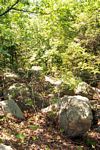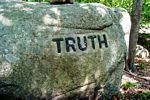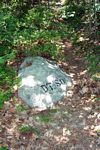Home > Gloucester
Dogtown
Location, History, and Legends
Location
 Dogtown is an area in central Gloucester of about five square
miles, or 3600 acres, stretching from the Riverdale section
of the city, north of Route 128, into Rockport, and including
the Goose Cove and the Babson Reservoirs. Development is banned
in this protected municipal watershed.
Dogtown is an area in central Gloucester of about five square
miles, or 3600 acres, stretching from the Riverdale section
of the city, north of Route 128, into Rockport, and including
the Goose Cove and the Babson Reservoirs. Development is banned
in this protected municipal watershed.
Dogtown is known for its woods and for its boulders and rock
formations left behind when the last glaciers melted. Because
of the availability of water, in 1642, the Commons Settlement
was located here and was for a century the most prosperous
part of Gloucester. The half century after the Revolutionary
War saw the decline and disappearance of the Dogtown settlement,
and today, visitors to Dogtown try to find the numbered boulders
which mark the cellar holes of the houses in this “ghost
town,” as well other boulders emblazoned with inspirational
messages. The poetry of Dogtown is about both its rocks and
natural beauty and the lives of its former residents.
 The famous American artist and poet Marsden Hartley described
Dogtown as a cross between Stonehenge and Easter Island, a feeling captured in his painting, “In the Moraine: Dogtown Common; Cape Ann, 1931.” Gloucester’s
Roger Babson, the “creator” of modern Dogtown loved
both its boulders and forsaken cellars. Today, a network of
abandoned roads and trails enable walkers to discover Dogtown.
Of course, visitors to Dogtown should always exercise every
safety precaution and environmental consideration.
The famous American artist and poet Marsden Hartley described
Dogtown as a cross between Stonehenge and Easter Island, a feeling captured in his painting, “In the Moraine: Dogtown Common; Cape Ann, 1931.” Gloucester’s
Roger Babson, the “creator” of modern Dogtown loved
both its boulders and forsaken cellars. Today, a network of
abandoned roads and trails enable walkers to discover Dogtown.
Of course, visitors to Dogtown should always exercise every
safety precaution and environmental consideration.
Directions to Dogtown
To reach Dogtown’s outskirts by automobile, from Grant
Circle on Route 128 (exit 11), take route 127 North. Within
the first mile, take a right on either Dr. Osman Babson Rd.
or Reynard St. and proceed up to Cherry St. Take a left and
look for Dogtown Rd. on the right. Drive up the paved road
to the parking area, and then walk to the end of the paved
section of Dogtown Road, past the rifle club and the public
works area. Follow the unpaved Dogtown Road to Dogtown Square,
and the bear right for the Babson Boulder Trail which is on
the right soon thereafter.
History
As
many people are interested in Dogtown’s natural history
and its geological features as are interested in Dogtown’s
economic decline and depression and the people who lived there
then.
 According to Roger Babson, the founder of Babson College,
the history of settlement in Dogtown illustrated the four stages
of the business cycle: improvement, prosperity, decline, and
depression. Dogtown’s development and prosperity lasted
from about 1650 until 1750. During this time, the area was
home to Gloucester’s most prominent families, and since
it was directly connected by road to all of Cape Ann’s
seashore communities, the Commons Settlement, as it was called,
was a thriving and successful hub of agriculture, timbering,
and transportation.
According to Roger Babson, the founder of Babson College,
the history of settlement in Dogtown illustrated the four stages
of the business cycle: improvement, prosperity, decline, and
depression. Dogtown’s development and prosperity lasted
from about 1650 until 1750. During this time, the area was
home to Gloucester’s most prominent families, and since
it was directly connected by road to all of Cape Ann’s
seashore communities, the Commons Settlement, as it was called,
was a thriving and successful hub of agriculture, timbering,
and transportation.
A change in economic conditions after 1750 brought about the
decline of the Commons Settlement and the onset of Dogtown.
Deforestation, an absence of pirates, and the victory over
the British in the Revolutionary War brought the Commons Settlement’s
more successful families to the harbor. Their properties were
rented, often to the less well-to-do, and sometimes to widows
of Revolutionary War soldiers, whose use of dogs for protection
and companionship helped coin the name Dogtown. Until 1830,
when the last resident of Dogtown, Black Neil, was taken to
the poorhouse, the area spiraled downward into a depression.
It was during this era that many of the colorful characters
that have come to be associated with Dogtown made their impressions
on Gloucester history and lore.
 The modern twentieth century history of Dogtown is the story
of its becoming a natural resource for Gloucester. Naturalist,
historian, and philanthropist Roger Babson (1875-1967) is the
man most responsible for this. Babson the historian mapped
and numbered Dogtown’s cellar holes and inscribed boulders
to help locate them, thus creating a natural “theme park”.
During the Depression, Babson the philanthropist hired unemployed
stonecutters to carve 24 inspirational mottoes on Dogtown boulders,
many on the Babson Boulder Trail. Eventually, the Babson family
gave Babson Reservoir to the city to ensure an independent
water supply, and in return, the city agreed to keep Dogtown
an undeveloped public park. Since 1985, the Dogtown Advisory
Committee has fought to preserve the natural environment of
Dogtown, in the process creating a detailed topographical trail
map of Dogtown available at local bookstores.
The modern twentieth century history of Dogtown is the story
of its becoming a natural resource for Gloucester. Naturalist,
historian, and philanthropist Roger Babson (1875-1967) is the
man most responsible for this. Babson the historian mapped
and numbered Dogtown’s cellar holes and inscribed boulders
to help locate them, thus creating a natural “theme park”.
During the Depression, Babson the philanthropist hired unemployed
stonecutters to carve 24 inspirational mottoes on Dogtown boulders,
many on the Babson Boulder Trail. Eventually, the Babson family
gave Babson Reservoir to the city to ensure an independent
water supply, and in return, the city agreed to keep Dogtown
an undeveloped public park. Since 1985, the Dogtown Advisory
Committee has fought to preserve the natural environment of
Dogtown, in the process creating a detailed topographical trail
map of Dogtown available at local bookstores.

The natural history of Dogtown is responsible for its natural
beauty. The most significant event in Dogtown’s natural
history was the melting of the glacier thousands of years ago.
Tons and tons of rocks and boulders were left behind by the
glacier, including an impressive terminal moraine, which can
be seen near Dogtown Square and from the Babson Boulder Trail.
Sometimes large and unique rock formations called erratics
were also left behind. Whale’s Jaw in the northern part
of Dogtown is the area’s most famous erratic. Residents
of the Commons Settlement used the rocks and boulders in the
area to build stone walls and stone cellars for their houses,
and of course, Roger Babson used the boulders to mark cellar
hole sites and display mottoes for self-improvement. In addition
to the rocks and terrain, a variety of plants, wildflowers,
and trees contribute to the natural beauty of Dogtown.
Legends
 Stories
about the lives of the residents of the Commons Settlement
and Dogtown abound. Roger Babson’s chapter on Dogtown
in his Cape Ann Tourist’s Guide (Gloucester: Cape Ann
Community League 1952) and Thomas Dresser’s Dogtown:
A Village Lost in Time (Franconia NH: Thorn Books 1995) provide
detailed and interesting sketches of many of these residents.
Stories
about the lives of the residents of the Commons Settlement
and Dogtown abound. Roger Babson’s chapter on Dogtown
in his Cape Ann Tourist’s Guide (Gloucester: Cape Ann
Community League 1952) and Thomas Dresser’s Dogtown:
A Village Lost in Time (Franconia NH: Thorn Books 1995) provide
detailed and interesting sketches of many of these residents.
During the Revolution, the Commons Settlement produced two
heroes. Isaac Dade (cellar hole 18) escaped impressment on
a British ship to fight in three battles and be badly wounded
at the Battle of Yorktown. Peter Lurvey (cellar hole 25) became
Gloucester’s most celebrated Minuteman in August 1775,
when the British ship “Falcon” sailed into Gloucester
harbor. Lurvey quit working in his field and ran to the harbor
recruiting comrades along the way. The “Falcon” was
driven out to sea, but Lurvey was killed in the action. Over
a century later, his heroism was the subject of a poem by Gloucester’s
banker-poet Hiram Rich.
 After the Revolution, when the Commons Settlement became known
as Dogtown, two among many legendary figures emerged: Judith
Rhines and Tammy Younger, “witches” behaving badly
during the depressed decades of Dogtown in the 1800’s.
The notorious activities of both sparked the imaginations of
Percy MacKaye, whose long narrative poem Dogtown Common (New
York: MacMillan 1921) explores a fictional romance between
Judith Rhines and minister John Wharf, and Francis Blessington,
whose 2001 novel, The Last Witch of Dogtown (Gloucester: Curious
Traveler Press) tells of the transformation of the fictional
Ganther Halliday by Rhines and Younger. Judith Rhines is also the central figure in best-selling author Anita Diamant's The Last Days of Dogtown (New York: Scribner 2005), a novel in which Tammy Younger is also present. And both Rhines and Younger are included in Elyssa East's non-fiction Dogtown: Death and Disenchantment in New England Ghost Town (New York: Free Press 2009).
After the Revolution, when the Commons Settlement became known
as Dogtown, two among many legendary figures emerged: Judith
Rhines and Tammy Younger, “witches” behaving badly
during the depressed decades of Dogtown in the 1800’s.
The notorious activities of both sparked the imaginations of
Percy MacKaye, whose long narrative poem Dogtown Common (New
York: MacMillan 1921) explores a fictional romance between
Judith Rhines and minister John Wharf, and Francis Blessington,
whose 2001 novel, The Last Witch of Dogtown (Gloucester: Curious
Traveler Press) tells of the transformation of the fictional
Ganther Halliday by Rhines and Younger. Judith Rhines is also the central figure in best-selling author Anita Diamant's The Last Days of Dogtown (New York: Scribner 2005), a novel in which Tammy Younger is also present. And both Rhines and Younger are included in Elyssa East's non-fiction Dogtown: Death and Disenchantment in New England Ghost Town (New York: Free Press 2009).
Finally, there is James Merry who became a Dogtown legend
in 1892, long after Dogtown ceased to exist. At 60, he still
believed he could wrestle to the ground a bull he had been
raising for three years. He had performed the feat in years
past, but this time the bull was too much for him and he died
in Dogtown of his injuries. The poet Charles Olson was drawn
to the Merry legend, some say because both were very tall and
broad, and Olson used the legend to anchor his long poem “Maximus
from Dogtown – 1.”
 Today, since Dogtown is a ghost town, visitors can touch the
lives of those who once lived there by finding numbered boulders
marking cellar holes and recalling Dogtown stories. In this
fashion, all residents of the Commons Settlement and Dogtown
whose cellar holes are marked have become legendary.
Today, since Dogtown is a ghost town, visitors can touch the
lives of those who once lived there by finding numbered boulders
marking cellar holes and recalling Dogtown stories. In this
fashion, all residents of the Commons Settlement and Dogtown
whose cellar holes are marked have become legendary.